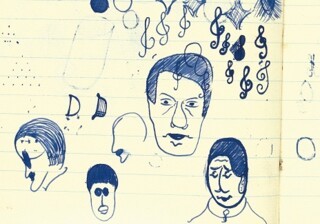A £962,500 Fart in the Corduroys
Christopher Tayler
Legal sanctions were in place against the talking cure in Ireland when Samuel Beckett decided to give it a shot. He'd beenhaving panic attacks since his father’s death in 1933. So in 1934, aged 27, he moved to London, a place he didn’t much like but that at least wasn’t Dublin (where, he wrote in a letter, ‘you askfor a fish & they give you a piece of bog oak’). In addition to not believing that the Irish public ‘ever gave a fart in its corduroys for any form of art whatsoever’, he was on the run fromhis mother, who was, as he put it, ‘alertly bereaved’ and also prone to unlettered bourgeois notions concerning salaried employment. When not discussing her with his analyst, Wilfred Bion, a futurepioneer of group therapy, Beckett read widely, moped in galleries and parks, visited a doctor friend working at the Bethlem Royal Hospital, and generally gathered the material that went intoMurphy, his first published novel.
Written between August 1935 and June 1936, Murphy was eventually accepted by Routledge after an extended bout of rejections and published in March 1938. Sales weren’t stellar – 568 copies inthe first year, dropping to seven in 1941 – and reviewers were a bit baffled. In the New English Weekly Dylan Thomas called it ‘difficult, serious, and wrong’. Kate O’Brien was kinder in theSpectator and Brian Coffey, an Irish poet Beckett knew, wrote a thoughtful appreciation which didn’t make it into print. In the mid-1930s Beckett could be pissy about ‘Coffee’, as he wasabout nearly everyone then, but he warmed to him later and at some point down the line made him a gift of the manuscript. Coffey sold it in the 1960s and it disappeared into a collector’s hoard,where it started to generate plaintive footnotes about scholarly non-access. Most of what was known about it came from James Knowlson, who wangled a brief inspection in a bank vault in London in1976. Even after he’d landed the role of Beckett’s official biographer, though, Knowlson wasn’t allowed a closer look.
So it felt quite strange to show up at Sotheby’s the other day, withthe sun beating hard on the nothing new, walk into an air-conditioned room in which Beckett enthusiasts were the only people not in suits, and be allowed to leaf through the holograph notebooks,headed ‘Sasha Murphy’, which were being sold ‘by order of the executors of the late Stanley Eker’. (Why ‘Sasha’? No one seems to know for sure, but perhaps it’s a private joke about Russian novels:Beckett wrote that he wasn’t sure he’d avoided the ‘Aliosha mistake’ in his handling of the title character.) There were, as Knowlson reported, six of them, and Gabriel Heaton, the Sotheby’sspecialist in charge, was unfazed when I reverently asked if I could snap the 1930s road safety advice for children printed on the back of Notebook V. (‘Don’t forget to walk on the footpath – ifthere is one.’ A subliminal prompt for the famous bull – ‘Do not come down the ladder, they have taken it away’ – in chapter 9?)
Beckett doodled when he got stuck, and like the drafts of Watt, at the Harry RansomCenter in Austin, Texas, the Murphy notebooks are filled with, in the catalogue’s words, ‘faces and human figures, bowler-hatted figures, golfers, a mermaid, bicycles, syringes (?), musicalnotations, flowers and abstract shapes’, plus recognisable drawings of Charlie Chaplin in tramp guise, Beckett himself and James Joyce.
He also had, in the opinion of a manuscript specialist consulted by the editors of his letters, ‘the worst handwriting of any 20th-century author’, and I felt increasingly grateful to Heaton as hewalked me through the hard-to-decipher highlights: nine pages of scratched-out stabs at the opening paragraph; deleted versions of Mr Endon’s unusual game of chess; extensive doodlings and crossings out in thenotebook Beckett worked in during an unhappy visit home; dating seemingly showing that the closing kite-flying scene was written at a single sitting.
As we both understood, though, textual inquiry takes second place to feeling that you're somehow in Beckett's presence when you’re looking at his physical handiwork in an auction house. Who werethey expecting to pay a million quid for it? The Harry Ransom Center? Yes, they were anticipating institutional bidders. ‘But the thing about Beckett,’ Heaton said, ‘is that there are lots of veryenthusiastic people outside the academic world too.’ It wasn’t impossible, he reckoned, that some super-rich fan might try to snap it up. Through a complex chain of association involving The Fast Show, I started to picture Johnny Depp gloatingover the notebooks on a yacht. But in the event Knowlson, representing the University of Reading, came through with the winning bid of £962,500.

Comments
As for Coffey barely ruffling the stubby secondary-feathers of the Academy with regard to Beckett (he ruffled them a bit in his own right as a poet), it's true that he's mostly a minor figure in the main biographical narratives. Anthony Cronin's fun and highly non-academic biography details Beckett's early pissiness towards him, but Cronin's book is sometimes better on Dublin literary gossip than it is on facts. Knowlson details his Spinoza-lending activities (Beckett found it easier going in French and Latin than in English) and the editors of Beckett's letters write: 'Coffey and SB corresponded often in the later years; SB appreciated his writing and his efforts to make [Denis] Devlin's poetry available.'